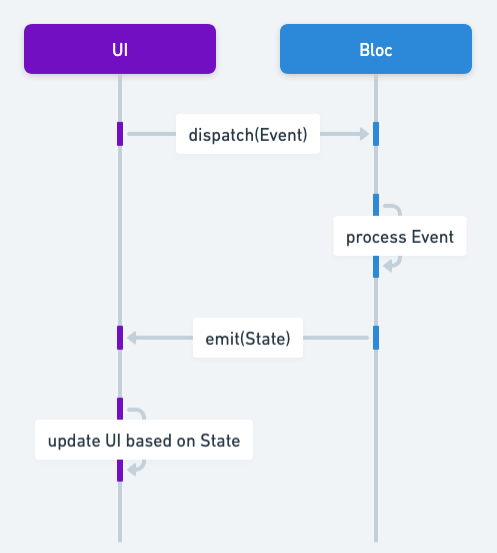Bloc Pattern in Java: State Management Simplified
Also known as
- Business Logic Component
- Business Logic Controller
Intent of the Bloc Pattern
The Bloc pattern manages the state of an object and allows for dynamically notifying interested listeners about state changes. It separates state management logic from the rest of the application, improving code organization and flexibility.
Detailed explanation of the Bloc pattern with real-World examples
Real-world example
Consider a digital counter application where multiple parts of the UI need to be updated whenever the counter changes. For example, a label displaying the counter value and an activity log showing changes. Instead of directly modifying these UI components, the Bloc pattern manages the counter state and notifies all registered listeners about the state change. Listeners can dynamically subscribe or unsubscribe from receiving updates.
In plain words
The Bloc pattern manages a single state object and dynamically notifies registered listeners whenever the state changes.
Wikipedia says
While not a formalized "Gang of Four" design pattern, Bloc is widely used in state-driven applications. It centralizes state management and propagates state changes to registered observers, following principles of separation of concerns.
Sequence diagram

Programmatic Example of the Bloc Pattern in Java
This example demonstrates how to implement the Bloc pattern using Java and Swing. The pattern separates the state of the application from UI components, and provides a reactive, event-driven approach to managing updates.
Core components of the Bloc Pattern include a State object, a Bloc class responsible for managing and updating that state, and interfaces (StateListener and ListenerManager) for subscribing to changes.
The State class represents the application's data at any given time.
public record State(int value) {}The ListenerManager interface declares methods to add and remove listeners, as well as retrieve them.
public interface ListenerManager<T> {
void addListener(StateListener<T> listener);
void removeListener(StateListener<T> listener);
List<StateListener<T>> getListeners();
}The StateListener interface defines how a listener reacts to state changes.
public interface StateListener<T> {
void onStateChange(T state);
}The Bloc class maintains the current state and notifies listeners of updates. It provides increment and decrement methods to update state and automatically notify registered listeners.
public class Bloc implements ListenerManager<State> {
private State currentState;
private final List<StateListener<State>> listeners = new ArrayList<>();
public Bloc() {
this.currentState = new State(0);
}
@Override
public void addListener(StateListener<State> listener) {
listeners.add(listener);
listener.onStateChange(currentState);
}
@Override
public void removeListener(StateListener<State> listener) {
listeners.remove(listener);
}
@Override
public List<StateListener<State>> getListeners() {
return Collections.unmodifiableList(listeners);
}
private void emitState(State newState) {
currentState = newState;
for (StateListener<State> listener : listeners) {
listener.onStateChange(currentState);
}
}
public void increment() {
emitState(new State(currentState.value() + 1));
}
public void decrement() {
emitState(new State(currentState.value() - 1));
}
}This class demonstrates how to integrate the Bloc pattern with a simple Swing GUI. It sets up a counter, buttons to change the state, and a toggle to enable or disable the listener dynamically.
public class Main {
public static void main(String[] args) {
BlocUi blocUi = new BlocUi();
blocUi.createAndShowUi();
}
}
public class BlocUi {
public void createAndShowUi() {
final Bloc bloc = new Bloc();
JFrame frame = new JFrame("BloC example");
frame.setDefaultCloseOperation(WindowConstants.EXIT_ON_CLOSE);
frame.setSize(400, 300);
JLabel counterLabel = new JLabel("Counter: 0", SwingConstants.CENTER);
counterLabel.setFont(new Font("Arial", Font.BOLD, 20));
JButton decrementButton = new JButton("Decrement");
JButton toggleListenerButton = new JButton("Disable Listener");
JButton incrementButton = new JButton("Increment");
frame.setLayout(new BorderLayout());
frame.add(counterLabel, BorderLayout.CENTER);
frame.add(incrementButton, BorderLayout.NORTH);
frame.add(decrementButton, BorderLayout.SOUTH);
frame.add(toggleListenerButton, BorderLayout.EAST);
StateListener<State> stateListener = state -> counterLabel.setText("Counter: " + state.value());
bloc.addListener(stateListener);
toggleListenerButton.addActionListener(
e -> {
if (bloc.getListeners().contains(stateListener)) {
bloc.removeListener(stateListener);
toggleListenerButton.setText("Enable Listener");
} else {
bloc.addListener(stateListener);
toggleListenerButton.setText("Disable Listener");
}
});
incrementButton.addActionListener(e -> bloc.increment());
decrementButton.addActionListener(e -> bloc.decrement());
frame.setVisible(true);
}
}Program Output
On Increment
Counter: 1On Decrement
Counter: 0Dynamic Listener Toggle
- Listener disabled: Counter stops updating.
- Listener enabled: Counter updates again.
When to Use the Bloc Pattern
Use the Bloc pattern when:
- When you want a clean separation of business logic and UI in Java applications
- When you need a reactive approach to updating UI based on state changes
- When you want to avoid coupling controllers or presenters directly to data manipulation
- When multiple UI elements need access to the same business logic
Real-World Applications of Bloc Pattern
- Java-based desktop applications that require real-time UI updates
- Backend-driven Java frameworks that separate service layers from presentation
- Cross-platform applications where the logic must remain consistent regardless of the UI technology
Benefits and Trade-offs of Bloc Pattern
Benefits:
- Simplifies UI components by removing direct business logic
- Improves testability by isolating state and behavior
- Encourages code reuse by centralizing data flows
- Enhances maintainability through clear separation of concerns
Trade-offs:
- May introduce additional boilerplate code for managing streams or observers
- Requires careful design to avoid a monolithic “god” component
- Demands consistent reactive programming practices to be effective
Related Patterns
- Observer: Bloc is a specialized implementation of the Observer pattern.
- Mediator: Orchestrates interactions among multiple objects through a central component
- MVC: Shares the idea of separating concerns between layers